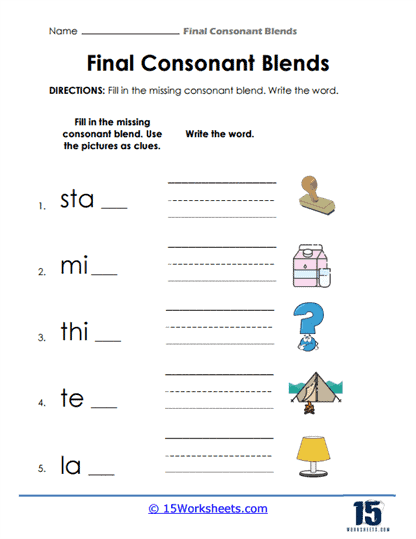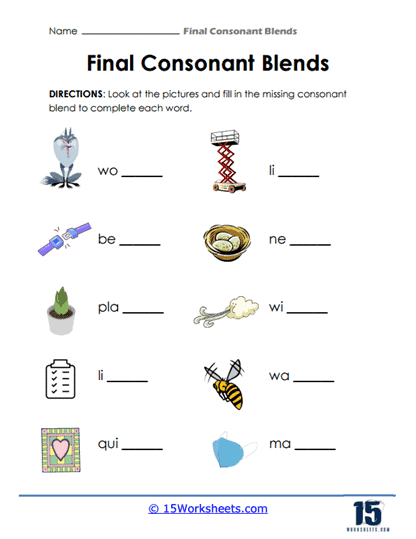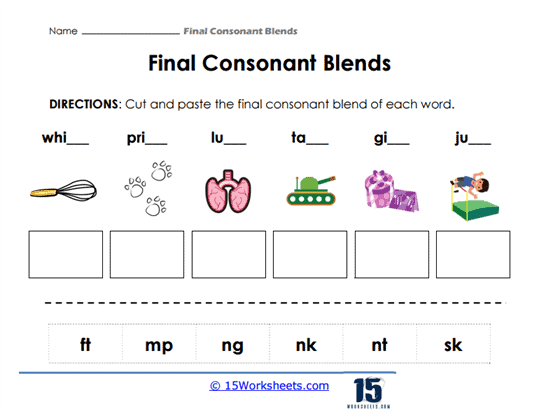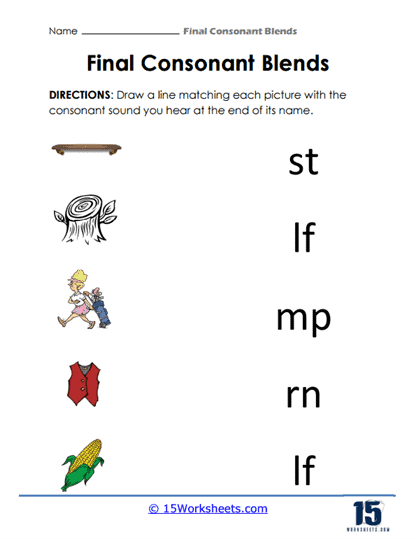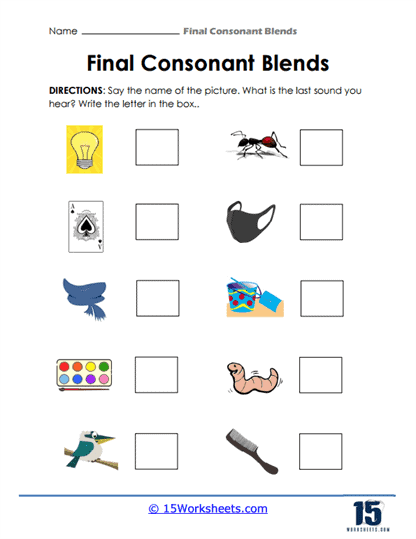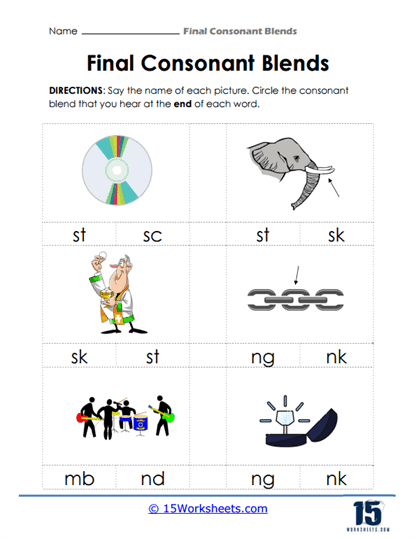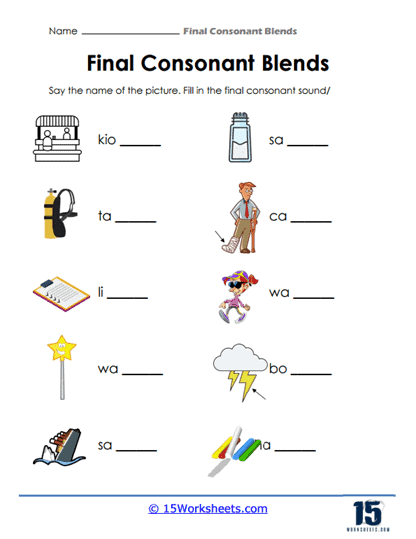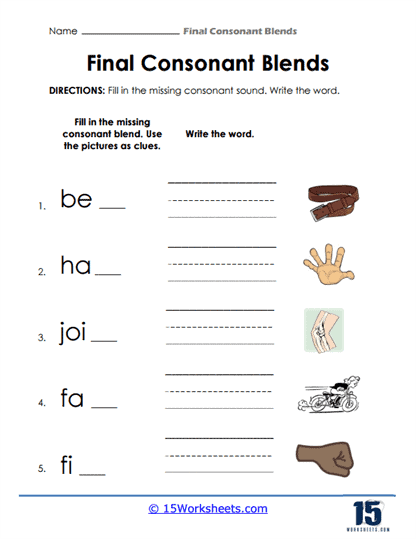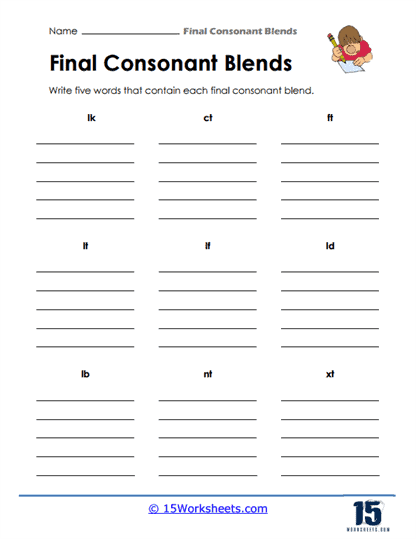Final Consonant Blends Worksheets
All About These 15 Worksheets
These worksheets are used primarily by students, teachers, homeschoolers, and tutors to reinforce the concept of consonant blends at the ends of words. These worksheets focus on helping students identify, practice, and master the combination of two or more consonants that form a smooth, blended sound, such as “st,” “mp,” “nd,” and others. These blends occur commonly in English, and understanding them is a critical step in developing fluent reading and accurate spelling.
Final consonant blends can be challenging for young readers or English learners because the sounds of the letters blend together, making them difficult to distinguish or pronounce individually. These worksheets are designed to help students recognize, practice, and use these blends in everyday words, improving their phonics skills, reading comprehension, and spelling ability. The exercises are typically visual and interactive, which engage students in different types of learning styles-whether through pictures, writing, cutting and pasting, or circling correct answers.
Types of Exercises
There is a variety of exercises commonly found in final consonant blend worksheets, and based on the images provided, these exercises aim to provide a range of activities that can reinforce different aspects of final consonant blends. Here’s a breakdown of what you might expect from the collection:
Fill-in-the-Blanks with Visual Cues – In some exercises, students are provided with partial words and picture clues (such as “ma” or “co”), where they must fill in the final consonant blend (e.g., “mask,” “cold”). These tasks are excellent for building vocabulary and helping students associate pictures with the corresponding words and sounds. For example, the first worksheet shows a combination of pictures and word stems like “si,” “ma,” and “sa,” and the student must complete the word using the appropriate final consonant blend.
Identifying Final Sounds – Another type of activity is where students are shown pictures, such as a ring or a stamp, and they must identify the final consonant blend and complete the word. This helps them practice listening to the sounds at the end of the word and understanding the relationship between sound and spelling. The images here demonstrate exercises like “sta_” (stamp), “ri_” (ring), etc., where students are guided to fill in the missing blend.
Matching Pictures to Words – There are also matching activities where students are presented with pictures and must match them to the correct word by recognizing the final consonant blend. An example of this might be choosing between “kick” and “king” based on a picture of a king, or between “skunk” and “skull,” focusing on the final sound. This type of exercise encourages students to visually associate the word with its corresponding image.
Word Construction with Missing Blends – In more complex worksheets, students may be asked to write the entire word, filling in the missing consonant blend. For instance, they might be given a picture of a tent and need to fill in “te__” (tent), which reinforces their ability to spell correctly using final consonant blends. These exercises often come with pictures as clues, making them visually stimulating and helping students learn spelling in a context that feels concrete.
Listening and Sound Identification – Worksheets that focus on listening comprehension may ask students to look at a picture, say the word aloud, and write down the final consonant blend they hear. For example, a picture of a worm might prompt the student to recognize the “rm” blend in “worm.” The students are guided to write the final sound they hear and thus enhance their phonemic awareness.
Cut-and-Paste Activities – Some worksheets provide cut-and-paste activities where students are given partial words and must match or complete them by gluing the correct final consonant blends. For example, words like “whi__” for whisk or “pri__” for print require students to cut out the appropriate blend from a selection and paste it in place. These tactile activities are particularly engaging for younger students and those who benefit from hands-on learning.
Multiple-Choice Questions – Another common exercise is circling or coloring the correct final consonant blend. In this case, students may be shown a picture and asked to circle or highlight the correct word from several options. For instance, if presented with a picture of a ring, they might need to choose between “ring,” “rin,” or “rink.”
Advanced Blending and Spelling Challenges – For more advanced students, worksheets may present final blends in more complex words and phrases, helping them prepare for spelling and reading at a higher level. These worksheets may involve writing full sentences, identifying blends in longer words, or even creating their own words based on prompts.
What Are Final Consonant Blends?
Final consonant blends refer to two or more consonants that appear together at the end of a word, where each consonant sound is distinctly heard. Unlike consonant digraphs, in which two consonants produce a single sound (e.g., “ch” in “rich”), consonant blends retain the individual sounds of each letter. For example, in the word “help,” the “l” and “p” are pronounced separately but blend together. These blends are a common feature in English and contribute to a wide range of word constructions, making them an essential part of early phonics instruction.
Learning final consonant blends is crucial because it helps students decode words more efficiently and improves their spelling. Recognizing the individual sounds of each letter in a blend allows students to tackle new words with greater confidence. This skill is particularly important as students advance beyond simple, single-consonant endings and encounter more complex words in their reading. Mastering final consonant blends provides a strong foundation for fluency, which is key to becoming a proficient reader.
Understanding final consonant blends aids in the development of reading fluency. When students can easily identify and pronounce the individual sounds in these blends, they can read more smoothly without having to pause and decode each word laboriously. This fluency allows them to focus on comprehension rather than decoding, which is especially important as they encounter longer and more complex texts. Fluent reading also enhances students’ enjoyment of reading, promoting a positive attitude toward learning.
Final consonant blends are equally important in spelling. Once students recognize the patterns and sounds associated with these blends, they are better equipped to spell words accurately. For instance, when writing a word like “ask,” understanding that “s” and “k” retain their individual sounds in the blend helps prevent spelling errors. Strong spelling skills are directly linked to a student’s ability to communicate clearly and effectively in writing, making this phonics skill a foundational aspect of literacy development.
Mastering final consonant blends helps expand a student’s vocabulary and improve word recognition. As students become familiar with common blends such as “nd,” “mp,” and “st,” they are able to identify these patterns across different words, broadening their vocabulary. This, in turn, makes it easier for them to recognize and understand new words in context, supporting their overall literacy development.
Examples of Final Consonant Blends
“st” blend in the word “fast” – The consonants “s” and “t” are blended together at the end of the word, with both sounds pronounced separately.
“mp” blend in the word “jump” – The “m” and “p” sounds are clearly articulated at the end of the word but combine to form a smooth transition between them.
Bank – In “bank,” the final consonant blend “-nk” combines the /n/ and /k/ sounds, as in the place where money is kept or the side of a river. The blend gives the word a distinct ending sound common in English words.
Hand – The word “hand” ends with the consonant blend “-nd,” merging the /n/ and /d/ sounds to describe the part of the body at the end of the arm. This blend provides a soft yet definite ending to the word.
Fast – In “fast,” the final “-st” blend combines the /s/ and /t/ sounds, commonly used to describe something moving quickly. The blend is pronounced smoothly, creating a quick ending that matches the word’s meaning.
Milk – The word “milk” ends with the blend “-lk,” where the /l/ and /k/ sounds come together, often referring to the dairy product. This combination creates a gentle yet firm ending sound.
Lamp – The final consonant blend “-mp” in “lamp” merges the /m/ and /p/ sounds, typically referring to a light source. This blend results in a distinct ending sound that is easy to recognize in spoken language.




